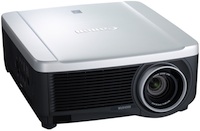Canon Launches WUXGA Installation LCoS Projector

Canon's REALiS WUX4000 will use new AISYS technology to deliver 20 percent more brightness per watt than its predecessor. |
Canon has debuted its first installation LCoS (liquid crystal on silicon) projector, the REALiS WUX4000. The new model, expected to ship in the first quarter of next year, sports a WUXGA resolution and is designed for larger venues like lecture halls and auditoriums.
The new WUX4000 offers a resolution of 1,920 x 1,200. It uses what Canon described as its "latest fourth-generation proprietary AISYS-enhanced LCoS optical engine" to deliver a contrast ratio of 1,000:1 and a brightness of 4,000 lumens. The fourth-generation AISYS (Aspectual Illumination System) produces 20 percent more brightness per lamp watt at a given panel size than its predecessor (used in the REALiS WUX10 projector), according to Canon. It also uses a new 3D look-up table and image correction technology to enhance the accuracy of color reproduction.
Other features include:
- Network connectivity via RJ-45;
- DICOM simulation;
- Motorized lens shift;
- Integrated 5 watt speaker; and
- Color controls including balance, levels, memory color correction, RGB gain, RGB offset, six-axis color adjustment, and temperature.
AV connectivity includes HDMI 1.3, DVI-D, and analog RGB video ports, as well as dual stereo minijack inputs and a single stereo minijack output. In addition to RJ-45, the projector includes an RS-232c control port.
The new model does not ship with a lens. There are three optional lenses available, including the RS-IL01ST (1.5:1 to 2.25:1 throw ratio, 1.5x optical zoom), the RS-IL02LZ (2.2:0 to 3.75:1 throw ratio, 1.7x optical zoom), and the fixed RS-IL03WF (0.8:1 throw ratio). All support motorized lens shift and are designed to work on screens ranging in size from 40 inches to 300 inches (diagonal).
The WUX4000 is expected to ship in March 2011. It will be priced at $8,999. Further information can be found here.